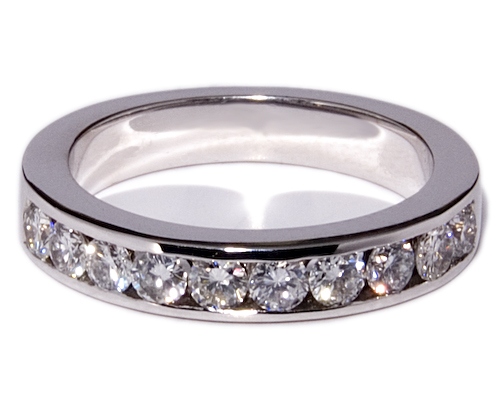Wedding bands | Wedding rings
There are countless suppositions and speculations about the history, meaning, and origins of wedding bands or wedding rings, but few traditions are as widespread and preserved as the exchange of wedding rings or wedding bands. This is where the origin of "wedding band" comes from: to ally oneself with someone for life.
It is not known exactly when this ritual began in history, but what really matters is not its traditional roots, but what it represents or symbolizes in a couple's union. Wedding rings or wedding bands are not vital or necessary items to be able to live in a relationship, but their ceremonial exchange is attributed a high symbolic value, and proof of this is their use in almost all marriages.
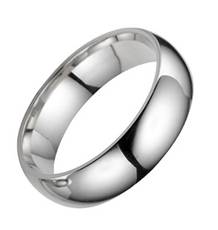
Perhaps it is the wearer of the ring who, as he or she changes his or her way of life (I mean the change of his or her marital status), acquires a series of commitments and responsibilities that, while true, can also be fulfilled without the ring. But I think it is the willingness to display the wedding ring on one's ring finger that denotes a commitment to freely accepted fidelity; a wedding band is a symbol that, by our own decision, commits us to the effort of putting all the means at our disposal to maintain fidelity with our partner, day after day. Few traditions are as preserved as wedding rings.
Origins of the tradition and rituals in history
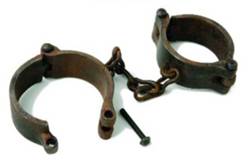
Regarding the origins of wedding rings, there are two schools of thought or theories. The first one is that wedding bands symbolize the shackles or hoops that ancient barbarians used to capture women from other tribes in order to make them their wives. Nowadays, since it is an exchange of rings, the ritual would not express the difference or inequality between sexes that the shackles represented in the past.
The second theory, which we support because we believe it to be more realistic and because there is data to support it, and therefore it is not a hypothesis like the previous one, is that the first wedding rings were exchanged in a union of a couple, symbolizing in the wedding rings the bond of the protagonists. Probably, in the origins of this tradition, in its pagan beginnings, there would be a sexual component or connotation; the action itself represents a penetration: the finger is the male phallic symbol and the ring represents the female sexual symbol; by inserting the ring into the finger, a penetration is personified - in full rule.
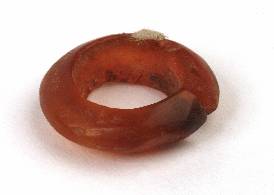
One of the oldest practices we know of regarding the use of wedding rings dates back to the time of the pharaohs in Ancient Egypt. Although this practice was probably earlier, there is evidence of this ritual from around 2700 BC, during the third dynasty of the Old Kingdom. Egyptian marriages were sealed by giving rings that, due to their circular shape, symbolized eternity, infinity; an endless line of the love they had pledged or promised. The rings were usually made of fabric, but were also made of other materials, including metal. If one belonged to a high social scale, they were made of gold. Egyptian couples renewed their promise of love every year and renewed their rings with new ones.
Around 1500 BC, the Hebrews also carried out the practice of exchanging wedding rings, with the difference being that the rings were placed on the index finger. It is believed that around the same time, in India, the practice of exchanging wedding rings was the same: they exercised the same symbolism, but the rings were worn on the thumb.
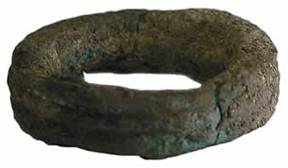
During the Ptolemaic period, this Egyptian ritual was adopted and adapted, and it was subsequently spread throughout all Hellenized territories. It is highly probable that it was the Greeks who rooted the custom of wearing the ring on the ring finger due to its anatomical classification, as they believed that a vein ran directly from this finger to the heart - making the symbolism of eternal love even greater - and this vein was called the "Vein of Love". The commitment of love and loyalty existed as long as the bearer's heart beat, which means "until death" (Christians adopted this symbolism: "till death do us part"). Another innovation that we must attribute to the Greeks is the interior inscriptions on wedding rings, symbolizing even more the union with the initials or the name of the person with whom the union was contracted, and the date of the celebration of the rite.
Later, the Romans adopted this tradition while retaining the meaning it had for the Greeks, as they shared the anatomical principles and treaties of the Greeks. Possibly, and symbolizing the hardness and durability of this material and evoking the god Saturn, in most cases, they were made of iron. When the Christian religion was embraced from Rome and throughout the empire, the rite was once again adopted - let us not forget that it had pagan origins - but redirected to the Trinitarian method of Christians, which consisted of inserting the ring on the thumb first, saying "in the name of the Father," then moving to the index finger and saying "of the Son," moving to the heart finger and saying "and of the Holy Spirit," and finally ending on the ring finger and saying "Amen". Hence, the name of the Trinitarian method or the Holy Trinity. It should be noted that Roman culture was the platform where the Christian religion was developed. It is normal that, over the years, Christians ended up adopting it (despite its pagan origin) and using the rite of wedding rings to finally make it their own. However, it took several centuries to be accepted and become a religious rite of Catholicism.
The subsequent manufacture of gold rings was motivated by the Catholic Church: making wedding rings in gold makes the product more expensive, so its acquisition requires a greater financial effort than other materials. With this, the Catholic Church wanted to give more value and increase the symbolism of the ring. Also, we do not get married every day; it is, therefore, a way to enhance the value of marriage.
